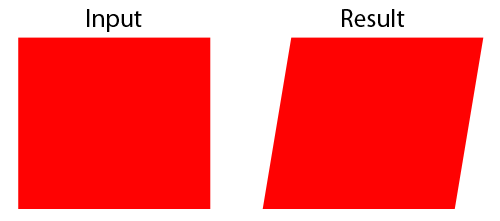How do vector applications skew polygons?
I know how to move, rotate, and scale, but how does skewing work? what would I have to do to a set of verticies to skew them?
Thank开发者_运维百科s
Offset X values by an amount that varies linearly with the Y value (or vice versa).
Edit: Doing this with a rectangle:
Let's say you start with a rectangle (0, 0), (4, 0), (4, 4), (0, 4). Let's assume you want to skew it with a slope of 2, so as it goes two units up, it'll move one to the right, something like this (hand drawn, so the angle's undoubtedly a bit wrong, but I hope it gives the general idea):

To get this, each X value is adjusted like:
X = X + Y * S
where S is the inverse of the slope of the skew. In this case, the slope is 2, so S = 1/2. Working that for our four corners, we get:
(0, 0) => 0 + 0 / 2 = 0 => (0, 0)
(4, 0) => 4 + 0 / 2 = 4 => (4, 0)
(4, 4) => 4 + 4 / 2 = 6 => (6, 4)
(0, 4) => 0 + 4 / 2 = 2 => (2, 4)
Skewing / shearing is described in detail at http://en.wikipedia.org/wiki/Shear_mapping and http://mathworld.wolfram.com/ShearMatrix.html
 加载中,请稍侯......
加载中,请稍侯......
精彩评论